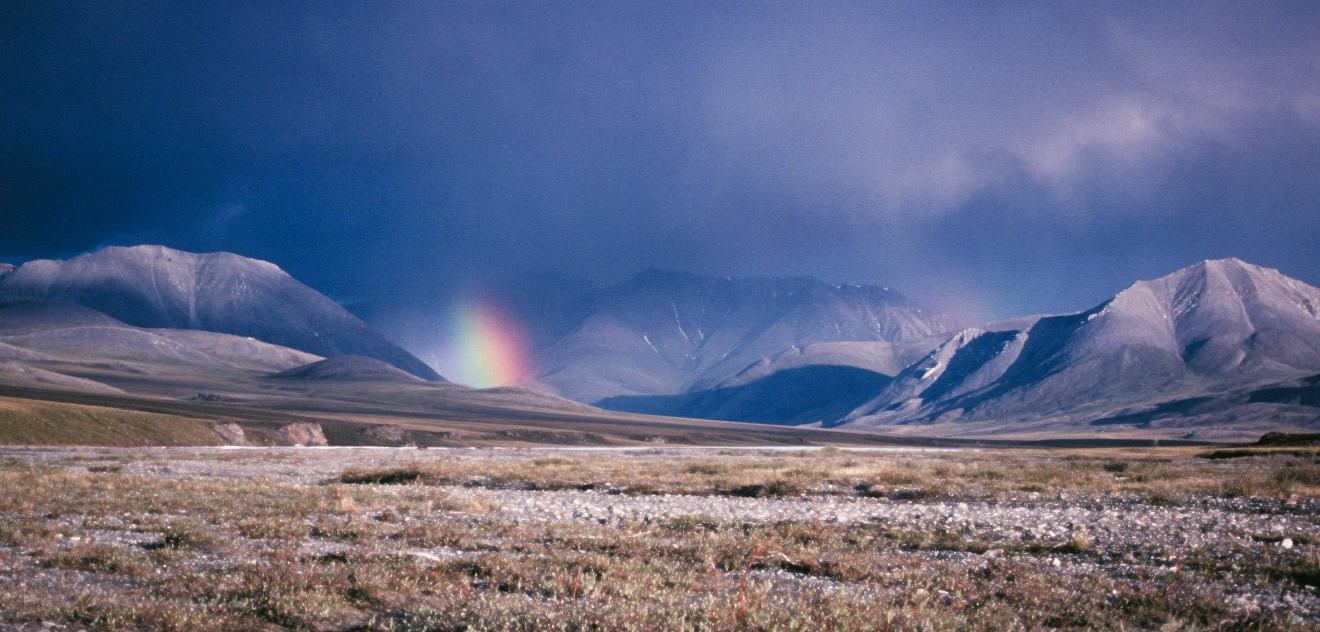Arctic National Wildlife Refuge still threatened
In September 2023, we celebrated the news that Interior Secretary Deb Haaland had canceled the last remaining Trump-era oil and gas leases in the Arctic National Wildlife Refuge in Alaska, which were held by the Alaska Industrial Development and Export Authority (AIDEA).
With the cancellation of those leases, the Bureau of Land Management (BLM) also issued a Draft Supplemental Environmental Impact Statement (SEIS) for public comment, as required by the so-called Tax Cuts and Jobs Act of 2017. The Draft SEIS attempts to correct flaws in the Trump-era EIS for the oil and gas leasing program on the Arctic Refuge’s coastal plain, triggering a public comment period that ran through November 7, 2023.
Wilderness Watch strongly opposes all oil and gas activities on the coastal plain of the Arctic Refuge. We recognize that a leasing program is required by law, but more has to be done to protect the coastal plain from oil and gas development. Lasting protection will only come by designating the entire Refuge as Wilderness.
Fossil fuel development would destroy the wild quality of both the coastal plain and adjacent Wilderness lands in the Arctic Refuge, and the Draft SEIS fails to truthfully explain what would be lost. Absent repeal of the provision in that law that opens the refuge to leasing, Wilderness Watch is advocating for stronger protections for onshore denning habitat for polar bears and for the Porcupine caribou herd. BLM also must consider the impact of climate change on migration routes and habitat, and the potential for oil and gas activities to further magnify these effects.
BACKGROUND:
The Arctic Refuge in the far northeast corner of Alaska is our largest National Wildlife Refuge at nearly 20 million acres, and is unparalleled in its wild grandeur, ecological wholeness, and vast scale. Nearly the entire Refuge is designated Wilderness or recommended for wilderness designation by the U.S. Fish & Wildlife Service. Polar bears, caribou, muskoxen, wolves, Dall sheep, brown bears, arctic foxes, and more than 200 species of birds depend on the Refuge for survival. Seventy percent of Americans support keeping the Refuge wild and free from fossil fuel extraction.
In 2017, Senator Lisa Murkowski (R-AK) and the Trump administration deviously circumvented normal lawmaking procedures to attach an amendment to the Tax Cut bill that opens the Coastal Plain of the Arctic National Wildlife Refuge to oil drilling and accompanying development with at least two oil lease sales required on the Refuge’s coastal plain over the next 10 years.
The bill required the Department of Interior to prepare an environmental impact statement (EIS) on potential development. The decision on the EIS was signed in August 2020 and recommended opening the entire coastal plain, 1.7 million acres, to oil and gas leasing and development.
On August 24, 2020, the Gwitch’in Nation, together with a coalition of conservation organizations, including Wilderness Watch, filed a lawsuit to stop the Administration’s decision to lease the Coastal Plain, and to turn America’s wildest landscape into another industrial wasteland. We filed a motion for a preliminary injunction to stop the Bureau of Land Management's (BLM) Janaury 6, 2021 oil or gas lease sale, but the motion was denied. The judge's ruling was narrow, holding that the lease sale doesn’t pose irreparable harm—a legal requirement for a preliminary injunction—since the lease sale doesn’t approve any ground-disturbing activity. The court concluded that before any ground-disturbing activity can be approved, additional environmental analysis will need to be conducted and that we could again seek an injunction to halt those activities. We are represented by Trustees for Alaska.
On January 6, 2021, the Bureau of Land Management (BLM) sold oil and gas drilling leases on more than half a million acres of the Coastal Plain. Additionally, associated seismic testing was proposed across nearly half a million acres of the Coastal Plain, and could kill or displace denning polar bears and turn the Refuge into an industrial wasteland crisscrossed by 90,000-pound “thumper” trucks, airstrips for helicopters and airplanes, bulldozers, tractors, incinerators, and more.
The Arctic Refuge had gained a reprieve on January 20, 2021, though, when President Biden issued an executive order placing a temporary moratorium on federal government activities aimed at implementing the oil and gas leasing program. Biden’s order, citing inadequate environmental review and related legal questions, directed the Secretary to review the leasing program and conduct a new environmental analysis.
Then on June 1, 2021, the Biden Administration suspended the oil and gas leasing program in the Arctic Refuge, and announced that it would complete its own analysis of the program’s environmental impacts, essentially throwing out the analysis done by the Trump Administration. In August 2023, a federal court in Alaska upheld the administration’s suspension of the oil and gas leasing program while it pursued a more robust environmental analysis, which was released as its SEIS in September 2023.
- Read the Secretarial Order
- Read the Executive Order (see Sect. 4 Arctic Refuge)
- Read the court’s decision on the TRO/PI
- Read the motion for TRO/PI
- Read the Gwich’in Steering Committee statement.
- Read the coalition news release on the lawsuit.
- Read the Legal Complaint.
- Read our scoping comments.
- Read our comments on the DEIS.
- Read a group comment letter we signed.
Contact Us
Wilderness Watch
P.O. Box 9175
Missoula, MT 59807
P: 406.542.2048
Press Inquiries: 406.542.2048 x2
E: wild@wildernesswatch.org
Minneapolis, MN Office
2833 43rd Avenue South
Minneapolis, MN 55406
P: 612.201.9266
Moscow, ID Office
P.O. Box 9765
Moscow, ID 83843

